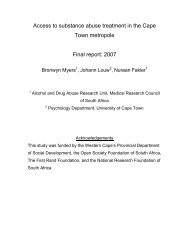Audit of Substance Abuse Treatment Facilities in ... - SA HealthInfo
Audit of Substance Abuse Treatment Facilities in ... - SA HealthInfo
Audit of Substance Abuse Treatment Facilities in ... - SA HealthInfo
- No tags were found...
You also want an ePaper? Increase the reach of your titles
YUMPU automatically turns print PDFs into web optimized ePapers that Google loves.
3.8 ADDRESSING BARRIERS TO ENGAGEMENT AND RETENTION INTREATMENT FOR VULNERABLE GROUPSThis section describes the extent to which treatment facilities target barriers toengagement and retention <strong>in</strong> treatment for clients from historically underserved groups;particularly Black South Africans, women and young people. Retention activities aregrouped <strong>in</strong>to activities relat<strong>in</strong>g to (i) the cultural-sensitivity and appropriateness <strong>of</strong>treatment, (ii) the gender-sensitivity and appropriateness <strong>of</strong> treatment, and (iii) the agesensitivityand appropriateness <strong>of</strong> treatment.Core f<strong>in</strong>d<strong>in</strong>gs:• All facilities <strong>of</strong>fer treatment services <strong>in</strong> multiple languages• Half <strong>of</strong> the facilities use culturally appropriate assessment tools• Only 43.8% <strong>of</strong> facilities provide child care services/facilities• Half <strong>of</strong> the facilities provide staff with special tra<strong>in</strong><strong>in</strong>g <strong>in</strong> gender-related issues• Three quarter <strong>of</strong> facilities employ staff tra<strong>in</strong>ed to work with young people• A small proportion <strong>of</strong> facilities (37.5%) provide adolescent-focused/adolescent-onlytreatment services3.8.1. Cultural and l<strong>in</strong>guistic sensitivity and appropriateness <strong>of</strong> treatmentOverall, all facilities report provid<strong>in</strong>g treatment programmes and materials <strong>in</strong> multiplelanguages, 87.5% provide counsell<strong>in</strong>g that is culturally appropriate, and only half reportus<strong>in</strong>g culturally appropriate assessment tools (Figure 20). Just over half <strong>of</strong> facilities(56.3%) have assessment <strong>in</strong>struments and programme materials translated <strong>in</strong>to multiplelanguages.54
















